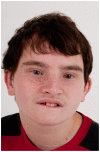Dubowitz syndrome is a complex comprised of multiple, genetically distinct and phenotypically overlapping disorders
- PMID: 24892279
- PMCID: PMC4043752
- DOI: 10.1371/journal.pone.0098686
Dubowitz syndrome is a complex comprised of multiple, genetically distinct and phenotypically overlapping disorders
Abstract
Dubowitz syndrome is a rare disorder characterized by multiple congenital anomalies, cognitive delay, growth failure, an immune defect, and an increased risk of blood dyscrasia and malignancy. There is considerable phenotypic variability, suggesting genetic heterogeneity. We clinically characterized and performed exome sequencing and high-density array SNP genotyping on three individuals with Dubowitz syndrome, including a pair of previously-described siblings (Patients 1 and 2, brother and sister) and an unpublished patient (Patient 3). Given the siblings' history of bone marrow abnormalities, we also evaluated telomere length and performed radiosensitivity assays. In the siblings, exome sequencing identified compound heterozygosity for a known rare nonsense substitution in the nuclear ligase gene LIG4 (rs104894419, NM_002312.3:c.2440C>T) that predicts p.Arg814X (MAF:0.0002) and an NM_002312.3:c.613delT variant that predicts a p.Ser205Leufs*29 frameshift. The frameshift mutation has not been reported in 1000 Genomes, ESP, or ClinSeq. These LIG4 mutations were previously reported in the sibling sister; her brother had not been previously tested. Western blotting showed an absence of a ligase IV band in both siblings. In the third patient, array SNP genotyping revealed a de novo ∼ 3.89 Mb interstitial deletion at chromosome 17q24.2 (chr 17:62,068,463-65,963,102, hg18), which spanned the known Carney complex gene PRKAR1A. In all three patients, a median lymphocyte telomere length of ≤ 1st centile was observed and radiosensitivity assays showed increased sensitivity to ionizing radiation. Our work suggests that, in addition to dyskeratosis congenita, LIG4 and 17q24.2 syndromes also feature shortened telomeres; to confirm this, telomere length testing should be considered in both disorders. Taken together, our work and other reports on Dubowitz syndrome, as currently recognized, suggest that it is not a unitary entity but instead a collection of phenotypically similar disorders. As a clinical entity, Dubowitz syndrome will need continual re-evaluation and re-definition as its constituent phenotypes are determined.
Conflict of interest statement
Figures












Similar articles
-
Alternative genomic diagnoses for individuals with a clinical diagnosis of Dubowitz syndrome.Am J Med Genet A. 2021 Jan;185(1):119-133. doi: 10.1002/ajmg.a.61926. Epub 2020 Oct 24. Am J Med Genet A. 2021. PMID: 33098347 Free PMC article.
-
Clinical and genetic heterogeneity in Dubowitz syndrome: Implications for diagnosis, management and further research.Am J Med Genet C Semin Med Genet. 2018 Dec;178(4):387-397. doi: 10.1002/ajmg.c.31661. Am J Med Genet C Semin Med Genet. 2018. PMID: 30580484
-
Deletion of 19q13 reveals clinical overlap with Dubowitz syndrome.J Hum Genet. 2015 Dec;60(12):781-5. doi: 10.1038/jhg.2015.111. Epub 2015 Sep 17. J Hum Genet. 2015. PMID: 26377242
-
[Dyskeratosis congenita: short telomeres are not the rule].Med Sci (Paris). 2012 Jun-Jul;28(6-7):618-24. doi: 10.1051/medsci/2012286015. Epub 2012 Jul 16. Med Sci (Paris). 2012. PMID: 22805138 Review. French.
-
Unraveling the pathogenesis of Hoyeraal-Hreidarsson syndrome, a complex telomere biology disorder.Br J Haematol. 2015 Aug;170(4):457-71. doi: 10.1111/bjh.13442. Epub 2015 May 4. Br J Haematol. 2015. PMID: 25940403 Free PMC article. Review.
Cited by
-
Identification of skewed X chromosome inactivation using exome and transcriptome sequencing in patients with suspected rare genetic disease.BMC Genomics. 2024 Apr 16;25(1):371. doi: 10.1186/s12864-024-10240-2. BMC Genomics. 2024. PMID: 38627676 Free PMC article.
-
PLXNA1 developmental encephalopathy with syndromic features: A case report and review of the literature.Am J Med Genet A. 2017 Jul;173(7):1951-1954. doi: 10.1002/ajmg.a.38236. Epub 2017 May 2. Am J Med Genet A. 2017. PMID: 28464511 Free PMC article.
-
DNA LIGASE IV SYNDROME: A RARE CAUSE OF GROWTH FAILURE & HYPOGONADISM.AACE Clin Case Rep. 2018 Nov 1;5(2):e154-e158. doi: 10.4158/ACCR-2018-0291. eCollection 2019 Mar-Apr. AACE Clin Case Rep. 2018. PMID: 31967023 Free PMC article.
-
Alternative genomic diagnoses for individuals with a clinical diagnosis of Dubowitz syndrome.Am J Med Genet A. 2021 Jan;185(1):119-133. doi: 10.1002/ajmg.a.61926. Epub 2020 Oct 24. Am J Med Genet A. 2021. PMID: 33098347 Free PMC article.
-
Mutations in the NHEJ component XRCC4 cause primordial dwarfism.Am J Hum Genet. 2015 Mar 5;96(3):412-24. doi: 10.1016/j.ajhg.2015.01.013. Epub 2015 Feb 26. Am J Hum Genet. 2015. PMID: 25728776 Free PMC article.
References
-
- Opitz JM, Pfeiffer RA, Hermann JP, Kushnick T (1973) Studies of malformation syndromes of man XXIV B: the Dubowitz syndrome. Further observations. Z Kinderheilkd 116: 1–12. - PubMed
-
- Tsukahara M, Opitz JM (1996) Dubowitz syndrome: review of 141 cases including 36 previously unreported patients. Am J Med Genet 63: 277–289. - PubMed
-
- Ahmad A, Amalfitano A, Chen YT, Kishnani PS, Miller C, et al. (1999) Dubowitz syndrome: a defect in the cholesterol biosynthetic pathway? Am J Med Genet 86: 503–504. - PubMed
-
- Hennekam RCM, Krantz ID, Allanson JE (2010) Dubowitz syndrome. Gorlin's Syndromes of the Head and Neck. 5th ed. Oxford: Oxford University Press. pp. 434–436.
Publication types
MeSH terms
Supplementary concepts
Grants and funding
LinkOut - more resources
Full Text Sources
Other Literature Sources
Medical
Research Materials
Miscellaneous

